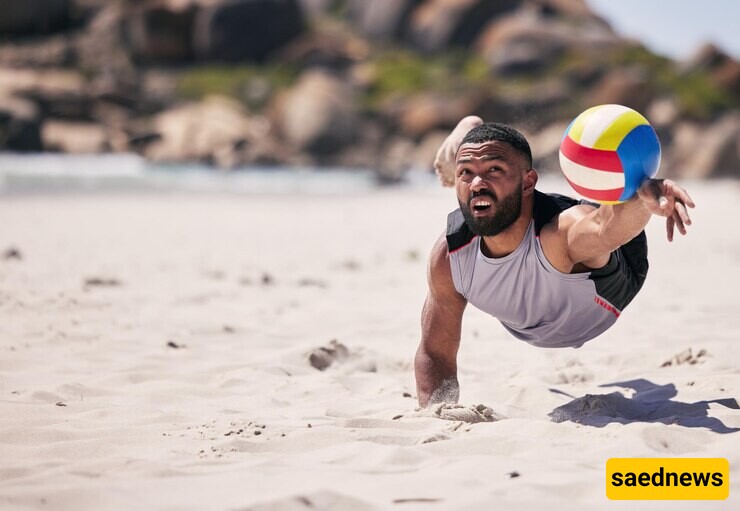SAEDNEWS: Footvolley is essentially beach volleyball, but played with a soccer ball. The matches are played in teams of two or three players. Each team is allowed a maximum of three touches to return the ball to the opposing side, and if the ball touches the ground, the opposing team is awarded a point.


Those seeing footvolley for the first time often compare it to Sepak Takraw, but the two sports are entirely different. Aside from the shape and size of the ball, athletes in Sepak Takraw are typically shorter for better striking efficiency, whereas footvolley players are usually taller and possess highly flexible, athletic builds. Footvolley requires enough physical flexibility for players to jump 220 cm and perform powerful spikes using their feet.
Players with a background in soccer tend to excel in footvolley, as the skills overlap significantly. The court for footvolley resembles a beach volleyball court but is slightly smaller. It must have a flat, even sand surface with dimensions of 18 x 9 meters. The net and ball are also distinct: the ball is similar in size and shape to a soccer ball but slightly lighter, and the net’s height in official matches is 220 cm.
Footvolley was born on the beaches of Rio de Janeiro, where Brazil’s excellence in soccer and volleyball inspired the blending of the two sports. The sport dates back more than 50 years. Brazilian soccer players, known for their skill in juggling the ball in the air, found it fascinating to play volleyball without letting the ball touch the ground.
Though the exact individual who first hit the ball with their foot instead of their hand remains unknown, what began as casual fun soon evolved into a form of training and eventually a standalone sport. Since 1980, footvolley has been recognized as a distinct sport with its own international federation. It spread from Rio de Janeiro to other Brazilian states and gradually gained global recognition, helped by the enthusiasm of Brazilian soccer stars who incorporated it into their training routines.
Over time, footvolley became an integral part of training sessions for major soccer teams, including Real Madrid, Manchester United, Chelsea, and more. Even Iran’s national soccer team has practiced a variation of the sport, known locally as "football tennis," using tennis nets and soccer balls due to a lack of proper footvolley facilities.
Iran officially joined the International Footvolley Federation in 2008, becoming the second Asian country after Thailand to adopt the sport. By 2010, footvolley was recognized as a distinct discipline by Iran’s Physical Education Organization and later came under the Federation of Sports Associations.

Domestic Stars
In Iran, legendary soccer player Ali Parvin, who enjoys volleyball, is an avid footvolley enthusiast, known for controlling the ball with his feet over the net. Other notable Iranian footvolley players include Ali Karimi, Pejman Jamshidi, Edmond Bezik, and others.
International Stars
Globally, Brazilian soccer legends such as Romário, Ronaldinho, Kaká, Ronaldo, and Roberto Carlos have played footvolley professionally or incorporated it into their training. The sport has now gained traction in numerous countries, including Argentina, Italy, Mexico, France, the Netherlands, and the United States. Renowned soccer players like Lionel Messi, Thierry Henry, Frank Lampard, and Fernando Torres have also participated in footvolley tournaments.
Footvolley follows rules similar to volleyball but is played with the feet. The game begins with a serve, where the server can build a small mound of sand to place the ball before striking it. Each team is allowed a maximum of three touches to return the ball to the opponent’s side. Points are scored when the ball lands on the opponent’s court, or the opposing team fails to return the ball.
Court Dimensions: A rectangular sand court, 18 x 9 meters. The free zone around the court must be at least 3 meters wide, extending to 5 meters for international matches.
Sand Surface: Uniform, level sand with a depth of at least 30 cm for international competitions. It must not be slippery or hazardous.
Net: Measures 9.5 meters in length and 1 meter in width, with a height of 220 cm for official adult matches.
Ball: Size and shape similar to a soccer ball, with a circumference of 67-70 cm, a weight lighter than a standard soccer ball, and an air pressure between 0.56-0.63. Recommended models include the Mikasa Kickoff SWL 310 and Mikasa FT5.
Poles: Support the net at a height of 255 cm and should be securely anchored into the ground.
For international competitions held at night, lighting must range between 100 and 1500 lux to ensure adequate visibility.
Footvolley combines the excitement of soccer and volleyball into a unique sport that has captivated players and fans worldwide. Its blend of skill, athleticism, and strategy makes it a thrilling game for participants and spectators alike.

